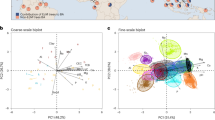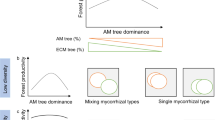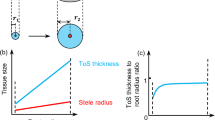Abstract
Ectomycorrhizal fungi dominate the humus layers of boreal forests. They depend on carbohydrates that are translocated through roots, via fungal mycelium to microsites in the soil, wherein they forage for nutrients. Mycorrhizal fungi are therefore sensitive to disruptive disturbances that may restrict their carbon supply. By disrupting root connections, we induced a sudden decline in mycorrhizal mycelial abundance and studied the consequent effects on growth and activity of free living, saprotrophic fungi and bacteria in pine forest humus, using molecular community analyses in combination with enzyme activity measurements. Ectomycorrhizal fungi had decreased in abundance 14 days after root severing, but the abundance of certain free-living ascomycetes was three times higher within 5 days of the disturbance compared with undisturbed controls. Root disruption also increased laccase production by an order of magnitude and cellulase production by a factor of 5. In contrast, bacterial populations seemed little affected. The results indicate that access to an external carbon source enables mycorrhizal fungi to monopolise the humus, but disturbances may induce rapid growth of opportunistic saprotrophic fungi that presumably use the dying mycorrhizal mycelium. Studies of such functional shifts in fungal communities, induced by disturbance, may shed light on mechanisms behind nutrient retention and release in boreal forests. The results also highlight the fundamental problems associated with methods that study microbial processes in soil samples that have been isolated from living roots.
Similar content being viewed by others
Log in or create a free account to read this content
Gain free access to this article, as well as selected content from this journal and more on nature.com
or
Accession codes
References
Allen TR, Millar T, Berch SM, Berbee ML . (2003). Culturing and direct DNA extraction find different fungi from the same ericoid mycorrhizal roots. New Phytol 160: 255–272.
Baldrian P . (2004). Increase of laccase activity during interspecific interactions of white-rot fungi. FEMS Microbiol Ecol 50: 245–253.
Berg B, Hannus K, Popoff T, Theander O . (1982). Changes in organic chemical components of needle litter during decomposition. Long-term decomposition in a Scots pine forest I. Can J Bot 60: 1310–1319.
Boberg J, Finlay R, Stenlid J, Näsholm T, Lindahl BD . (2008). Glucose and ammonium additions affect needle decomposition and carbon allocation by the litter degrading fungus. Mycena epipterygia Soil Biol Biochem 40: 995–999.
Boddy L . (1999). Saprotrophic cord-forming fungi: meeting the challenge of heterogeneous environments. Mycologia 91: 13–32.
Bödeker ITM, Nygren CMR, Taylor AFS, Olson Å, Lindahl BD . (2009). ClassII peroxidase encoding genes are present in a wide phylogenetic range of ectomycorrhizal fungi. ISME J 3: 1387–1395.
Bougoure DS, Parkin PI, Cairney JWG, Alexander IJ, Anderson IC . (2007). Diversity of fungi in hair roots of Ericaceae varies along a vegetation gradient. Mol Ecol 16: 4624–4636.
terBraak CJF . (1986). Canonical correspondence analysis: a new eigenvector technique for multivariate direct gradient analysis. Ecology 67: 1167–1179.
Brant JB, Myrold DD, Sulzman EW . (2006). Root controls on soil microbial community structure in forest soils. Oecologia 148: 650–659.
Butenschoen O, Poll C, Langel R, Kandeler E, Marhan S, Scheu S . (2007). Endogeic earthworms alter carbon translocation by fungi at the soil-litter interface. Soil Biol Biochem 39: 2854–2864.
Carmosini N, Devito KJ, Prepas EE . (2003). Net nitrogen mineralization and nitrification in trembling aspen forest soils on the Boreal Plain. Can J Forest Res 33: 2262–2268.
DeLuca TH, Keeney DR, McCarty GW . (1992). Effect of freeze-thaw events on mineralization of soil nitrogen. Biol Fert Soils 14: 116–120.
Fierer N, Bradford MA, Jackson RB . (2007). Toward an ecological classification of soil bacteria. Ecology 88: 1354–1364.
Finlay RD, Read DJ . (1986). The structure and function of the vegetative mycelium of ectomycorrhizal plants: I. Translocation of 14C-labelled carbon between plants interconnected by a common mycelium. New Phytol 103: 143–156.
Gadgil RL, Gadgil PD . (1971). Mycorrhiza and litter decomposition. Nature 233: 133.
Gloer JB . (2007). Applications of fungal ecology in the search for new bioactive natural products. In: Kubicek CP, Druzhinina IS (eds). Environmental and Microbial Relationships, 2nd edn, The Mycota IV. Springer-Verlag: Berlin, pp 257–283.
Hibbett DS, Ohman A, Kirk PM . (2009). Fungal ecology catches fire. New Phytol 184: 279–282.
Högberg MN, Högberg P . (2002). Extramatrical ectomycorrhizal mycelium contributes one-third of microbial biomass and produces, together with associated roots, half the dissolved organic carbon in a forest soil. New Phytol 154: 791–795.
Lapointe B, Bradley RL, Shipley B . (2005). Mineral nitrogen and microbial dynamics in the forest floor of clearcut or partially harvested successional boreal forest stands. Plant Soil 271: 27–37.
Lavoie M, Bradley RL . (2003). Short-term increases in relative nitrification rates due to trenching in forest floor and mineral soil horizons of different forest types. Plant Soil 252: 367–384.
Leake JR, Donnelly DP, Saunders EM, Boddy L, Read DJ . (2001). Rates and quantities of carbon flux to ectomycorrhizal mycelium following 14C pulse labeling of Pinus sylvestris seedlings: effects of litter patches and interaction with a wood- decomposer fungus. Tree Physiol 21: 71–82.
Lindahl BD, Finlay RD . (2006). Activities of chitinolytic enzymes during primary and secondary colonisation of wood by wood degrading basidiomycetes. New Phytol 169: 389–397.
Lindahl BD, Finlay RD, Cairney JWG . (2005). Enzymatic activities of mycelia in mycorrhizal fungal communities. In: Dighton J, Oudemans P, White J (eds). The Fungal Community: Its Organization and Role in the Ecosystem. Taylor & Francis: Boca Raton pp 331–348.
Lindahl BD, Ihrmark K, Boberg J, Trumbore SE, Högberg P, Stenlid J et al. (2007). Spatial separation of litter decomposition and mycorrhizal nitrogen uptake in a boreal forest. New Phytol 173: 611–620.
Lindahl BD, Olsson S . (2004). Fungal translocation—creating and responding to environmental heterogeneity. Mycologist 18: 79–88.
Lindahl B, Stenlid J, Finlay R . (2001). Effects of resource availability on mycelial interactions and 32P-transfer between a saprotrophic and an ectomycorrhizal fungus in soil microcosms. FEMS Microbiol Ecol 38: 43–52.
Lindahl B, Stenlid J, Olsson S, Finlay R . (1999). Translocation of 32P between interacting mycelia of a wood decomposing fungus and ectomycorrhizal fungi in microcosm systems. New Phytol 144: 183–193.
Lindahl BD, Taylor A, Finlay R . (2002). Defining nutritional constraints on carbon cycling—towards a less ‘phytocentric’ perspective. Plant Soil 242: 123–135.
Melillo JM, Aber JD, Linkins AE, Ricca A, Fry B, Nadelhoffer KJ . (1989). Carbon and nitrogen dynamics along the decay continuum—plant litter to soil organic-matter. Plant Soil 115: 189–198.
O’Brien HE, Parrent JL, Jackson JA, Moncalvo J-M, Vilgalys R . (2005). Fungal community analysis by large-scale sequencing of environmental samples. Appl Environ Microb 71: 5544–5550.
Persson T . (1980). Structure and Function of Northern Coniferous Forests—An Ecosystem Study. Ecological Bulletins 32: Stockholm, Sweden.
Piirainen S, Finér L, Mannerkoski H, Starr M . (2007). Carbon, nitrogen and phosphorus leaching after site preparation at a boreal forest clear-cut area. Forest Ecol Manag 243: 10–18.
Porter TM, Schadt CW, Rizvi L, Martin AP, Schmidt SK, Scott-Denton L et al. (2008). Widespread occurrence and phylogenetic placement of a soil clone group adds a prominent new branch to the fungal tree of life. Mol Phylogenet Evol 6: 635–644.
Rosling A, Lindahl BD, Finlay RD . (2004). Carbon allocation to ectomycorrhizal roots and mycelium colonising different mineral substrates. New Phytol 162: 795–802.
Read DJ, Perez-Moreno J . (2003). Mycorrhizas and nutrient cycling in ecosystems—a journey towards relevance? New Phytol 157: 475–492.
Schimel JP, Bennet J . (2004). Nitrogen mineralization: challenges of a changing paradigm. Ecology 85: 591–602.
Siira-Pietikäinen A, Haimi J, Kanninen A, Pietikäinen J, Fritze H . (2001). Responses of decomposer community to root-isolation and addition of slash. Soil Biol Biochem 33: 1993–2004.
Subke J-A, Hahn V, Battipaglia G, Linder S, Buchmann N, Cotrufo MF . (2004). Feedback interactions between needle litter decomposition and rhizosphere activity. Oecologia 139: 551–559.
Sulkava P, Huhta V . (2003). Effects of hard frost and freeze-thaw cycles on decomposer communities and N mineralisation in boreal forest soil. Appl Soil Ecol 22: 225–239.
Untereiner WA, Malloch D . (1999). Patterns of substrate utilization in species of Capronia and allied black yeasts: ecological and taxonomic implications. Mycologia 91: 417–427.
Varnaitė R, Paškevičius A, Raudonienė V . (2008). Cellulose degradation in rye straw by micromycetes and their complexes. Ekologija 54: 29–31.
Werner A, Zadworny M, Idzikowska K . (2002). Interaction between Laccaria laccata and Trichoderma virens in co-culture and in the rhizosphere of Pinus sylvestris grown in vitro. Mycorrhiza 12: 139–145.
Yarwood SA, Myrold DD, Högberg MN . (2009). Termination of belowground C allocation by trees alters soil fungal and bacterial communities in a boreal forest. FEMS Microbiol Ecol 70: 151–162.
Yavitt JB, Fahey TJ . (1984). An experimental analysis of solution chemistry in a Lodgepole pine forest floor. Oikos 43: 222–234.
Acknowledgements
Financial support from The Swedish Research Council for Environment, Agricultural Sciences and Spatial Planning (FORMAS) is gratefully acknowledged. We also thank Katarina Ihrmark, for valuable collaboration during method development, Fredrik Heyman and Wiecher Smant for assistance during field work and laboratory analyses, respectively, and Karina Clemmensen, for critical reading of the paper.
Author information
Authors and Affiliations
Corresponding author
Additional information
Supplementary Information accompanies the paper on The ISME Journal website
Rights and permissions
About this article
Cite this article
Lindahl, B., de Boer, W. & Finlay, R. Disruption of root carbon transport into forest humus stimulates fungal opportunists at the expense of mycorrhizal fungi. ISME J 4, 872–881 (2010). https://doi.org/10.1038/ismej.2010.19
Received:
Revised:
Accepted:
Published:
Issue date:
DOI: https://doi.org/10.1038/ismej.2010.19
Keywords
This article is cited by
-
Plant roots and associated mycelia enhance soil N transformation through different mechanisms in a karst plantation
Journal of Soils and Sediments (2023)
-
Ectomycorrhizal Stands Accelerate Decomposition to a Greater Extent than Arbuscular Mycorrhizal Stands in a Northern Deciduous Forest
Ecosystems (2022)
-
Medium-distance soil foragers dominate the Pinus hartwegii ectomycorrhizal community at the 3900 m Neotropical treeline
Symbiosis (2022)
-
Litter-inhabiting fungi show high level of specialization towards biopolymers composing plant and fungal biomass
Biology and Fertility of Soils (2021)
-
Fungal Succession During the Decomposition of Ectomycorrhizal Fine Roots
Microbial Ecology (2020)



